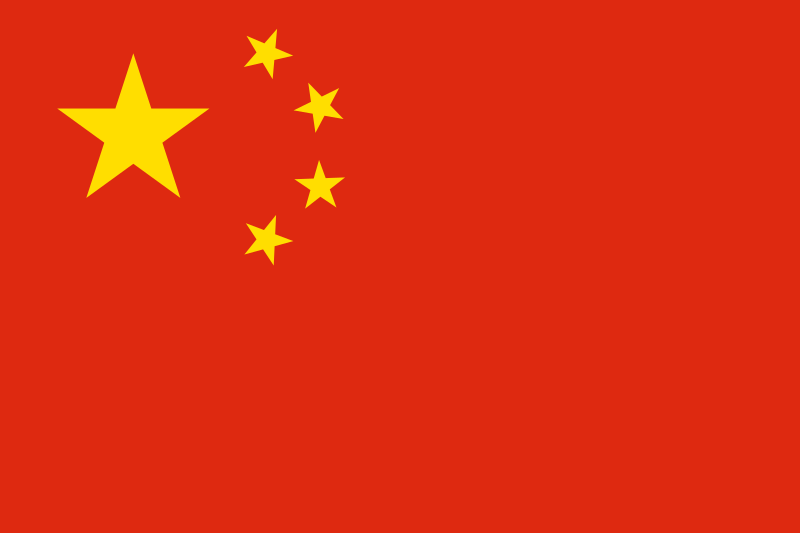National Symbols: Flag Details
Date First Used
October 1, 1949
Nickname(s)
“Wǔ Xīng Hóng Qí” (“Five Stars Red Flag”)
Design Elements
A red background; in the canton, four small gold stars arc around one large gold star.
Symbols: The large star represents the Communist Party of China; the four smaller stars represent the four occupations most esteemed by the Communist Party: farmers, workers, teachers, and soldiers. An historical interpretation suggests the four stars represent the traditional four categories of citizens of the state: workers (gōng), farmers (nóng), intellectuals (shì), and businessmen (shāng).
Colors: Red symbolizes revolution; yellow indicates the history and culture of the Chinese people (these colors were also inherited from the flag of the Soviet Union).
Proportions: 2:3
Variations: The war flag is a red flag with a gold star in the canton, beside which are the Chinese characters for "8" and "1" representing the date "August 1"; the naval ensign is a red flag, similar to the war flag, with alternating stripes of two -- blue and white -- in the lower third.
History
In a move congruent with the ideals espoused by the Communist Revolution, China picked the design for its national flag by committee. Of the 3,012 proposals received after a call for design submissions from the general public, 38 were chosen as finalists. Three of the final flag candidates displayed a large golden star (with no additional stars) with one, two or three yellow bars (horizontal) at the bottom of the flag, representing the Yangtze River, Huang He (Yellow River) and the Zhujiang River (Pearl River). These were not chosen by the officials, however, because the very presence of such bars appeared to suggest the idea of a tearing or splitting of the nation.
Eventually, a design from amateur painter Zeng Liansong, who lived in Shanghai, was picked. The choice underwent some immediate editing, however: in order to forge a separate identity from the Soviet Union, the hammer and sickle located within the large star on Zeng's design was removed by Mao's Zedong's direct decision. The design went through some additional tweaking and was finally approved by the Chinese People's Political Consultative Conference on September 27, 1949. It was officially unveiled in Beijing’s Tiananmen Square on October 1, 1949, the formal announcement of the founding of the People's Republic of China.
Proper Uses
China's Flag Law of 1990 states that “All citizens and organizations shall respect and care for the National Flag.” The flag should be displayed daily in Tiananmen Square and Xinhuamen in Beijing, the Standing Committee of the National People's Congress, the State Council, the Central Military Commission, the Supreme People's Court and the Supreme People's Procuratorate, the National Committee of the Chinese People's Political Consultative Conference, the Ministry of Foreign Affairs, and “airports, harbors and railway stations of entry or exit and other frontier ports, frontier stations and coastal defense stations.”
Full-time schools are required to display the national flag daily, except during winter vacations, summer vacations, and Sundays. The law also states that “no damaged, defiled, faded or substandard National Flag shall be displayed” nor can the flag be used as a trademark, for advertising purposes, or for use in “private funeral activities.” Criminal prosecution is assured for anyone who willfully desecrates the flag, with penalties entailing fines, prison sentences or both.
Legends, Controversies, and Trivia
The National Flag of the Republic of China (ROC) is commonly referred to in Chinese as “Blue Sky, White Sun, and a Wholly Red Earth” This sobriquet reflects the flag's attributes: a red background with a blue square featuring a white sun in the canton. This design was first used in mainland China in 1917 and was made the official flag of the ROC in 1928. The flag is considered invalid by the People's Republic of China (PRC), which now controls mainland China and claims to be the sole legitimate government of the territories currently controlled by the ROC, most notably Taiwan. The use of the ROC flag has been opposed by the People's Republic of China (PRC) because it suggests the ROC is legitimate, not a "rebellious province" as the PRC claims. However, since the early 2000s, the PRC has adopted a less bellicose attitude toward the ROC flag; this is in keeping with improved relations between the two nations.
Copyright © 1993—2024 World Trade Press. All rights reserved.

 China
China 